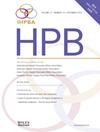Finetuning and optimizing an enhanced recovery protocol for liver surgery in the era of minimally invasive liver surgery: a single centre experience with 630 liver resections
IF 2.4
3区 医学
Q2 GASTROENTEROLOGY & HEPATOLOGY
引用次数: 0
Abstract
Background
Enhanced recovery after surgery (ERAS) principles are increasingly applied in liver surgery. The aim of this retrospective cohort study was to evaluate the effectiveness of optimized clinical pathways in liver surgery in conjunction with patient adherence to the ERAS-protocol.
Methods
Our centre implemented a first liver clinical pathway in 2015(CP1), followed by an optimized version in 2019(CP2). New ERAS-elements were introduced, such as no routine use of epidural analgesia and avoidance of surgical drains. More attention was paid to patient mobilization and resumption of a normal diet intake. Outcome measures included length of hospital stay, readmission rate, complications, and mortality. Adherence was measured by the percentage of patients who were discharged on or before the scheduled day.
Results
630 patients were included in the study, of which 329 (52.2 %) followed CP2 and 301 (47.8 %) followed CP1. The length of hospital stay after surgery significantly reduced in CP2(2[1–4]days vs 4[3–6]days; P < 0.001), without an increase in readmission rate (5.5 % vs 4.0% p:0.38), postoperative morbidity (12.5 % vs 14.3 %; P = 0.50) and 90-day mortality (0.91 % vs 1.00 %; P = 0.58). Adherence improved significantly in CP2(67.8 % vs 55.8 %; P = 0.002).
Conclusion
The implementation of an optimized CP in liver surgery resulted in a shorter hospital stay and higher adherence rate to the ERAS-protocol.
在微创肝手术时代,对肝脏手术的增强恢复方案进行微调和优化:630例肝脏切除术的单中心经验。
背景:手术后增强恢复(ERAS)原则越来越多地应用于肝脏手术。这项回顾性队列研究的目的是评估肝脏手术中优化临床路径的有效性,并结合患者对eras方案的依从性。方法:本中心于2015年实施首个肝脏临床路径(CP1),并于2019年实施优化版本(CP2)。引入了新的eras要素,如不常规使用硬膜外镇痛和避免手术引流。更多的关注病人的活动和恢复正常的饮食摄入。结果测量包括住院时间、再入院率、并发症和死亡率。依从性是通过在预定日期或之前出院的患者百分比来衡量的。结果:630例患者纳入研究,其中CP2 329例(52.2%),CP1 301例(47.8%)。术后住院时间CP2显著降低(2[1-4]天vs 4[3-6]天);P < 0.001),没有增加再入院率(5.5% vs 4.0% P:0.38),术后发病率(12.5% vs 14.3%;P = 0.50)和90天死亡率(0.91% vs 1.00%;P = 0.58)。CP2依从性显著改善(67.8% vs 55.8%;P = 0.002)。结论:在肝脏手术中实施优化的CP可缩短住院时间,提高ERAS-protocol的依从率。
本文章由计算机程序翻译,如有差异,请以英文原文为准。
求助全文
约1分钟内获得全文
求助全文
来源期刊

Hpb
GASTROENTEROLOGY & HEPATOLOGY-SURGERY
CiteScore
5.60
自引率
3.40%
发文量
244
审稿时长
57 days
期刊介绍:
HPB is an international forum for clinical, scientific and educational communication.
Twelve issues a year bring the reader leading articles, expert reviews, original articles, images, editorials, and reader correspondence encompassing all aspects of benign and malignant hepatobiliary disease and its management. HPB features relevant aspects of clinical and translational research and practice.
Specific areas of interest include HPB diseases encountered globally by clinical practitioners in this specialist field of gastrointestinal surgery. The journal addresses the challenges faced in the management of cancer involving the liver, biliary system and pancreas. While surgical oncology represents a large part of HPB practice, submission of manuscripts relating to liver and pancreas transplantation, the treatment of benign conditions such as acute and chronic pancreatitis, and those relating to hepatobiliary infection and inflammation are also welcomed. There will be a focus on developing a multidisciplinary approach to diagnosis and treatment with endoscopic and laparoscopic approaches, radiological interventions and surgical techniques being strongly represented. HPB welcomes submission of manuscripts in all these areas and in scientific focused research that has clear clinical relevance to HPB surgical practice.
HPB aims to help its readers - surgeons, physicians, radiologists and basic scientists - to develop their knowledge and practice. HPB will be of interest to specialists involved in the management of hepatobiliary and pancreatic disease however will also inform those working in related fields.
Abstracted and Indexed in:
MEDLINE®
EMBASE
PubMed
Science Citation Index Expanded
Academic Search (EBSCO)
HPB is owned by the International Hepato-Pancreato-Biliary Association (IHPBA) and is also the official Journal of the American Hepato-Pancreato-Biliary Association (AHPBA), the Asian-Pacific Hepato Pancreatic Biliary Association (A-PHPBA) and the European-African Hepato-Pancreatic Biliary Association (E-AHPBA).
 求助内容:
求助内容: 应助结果提醒方式:
应助结果提醒方式:


